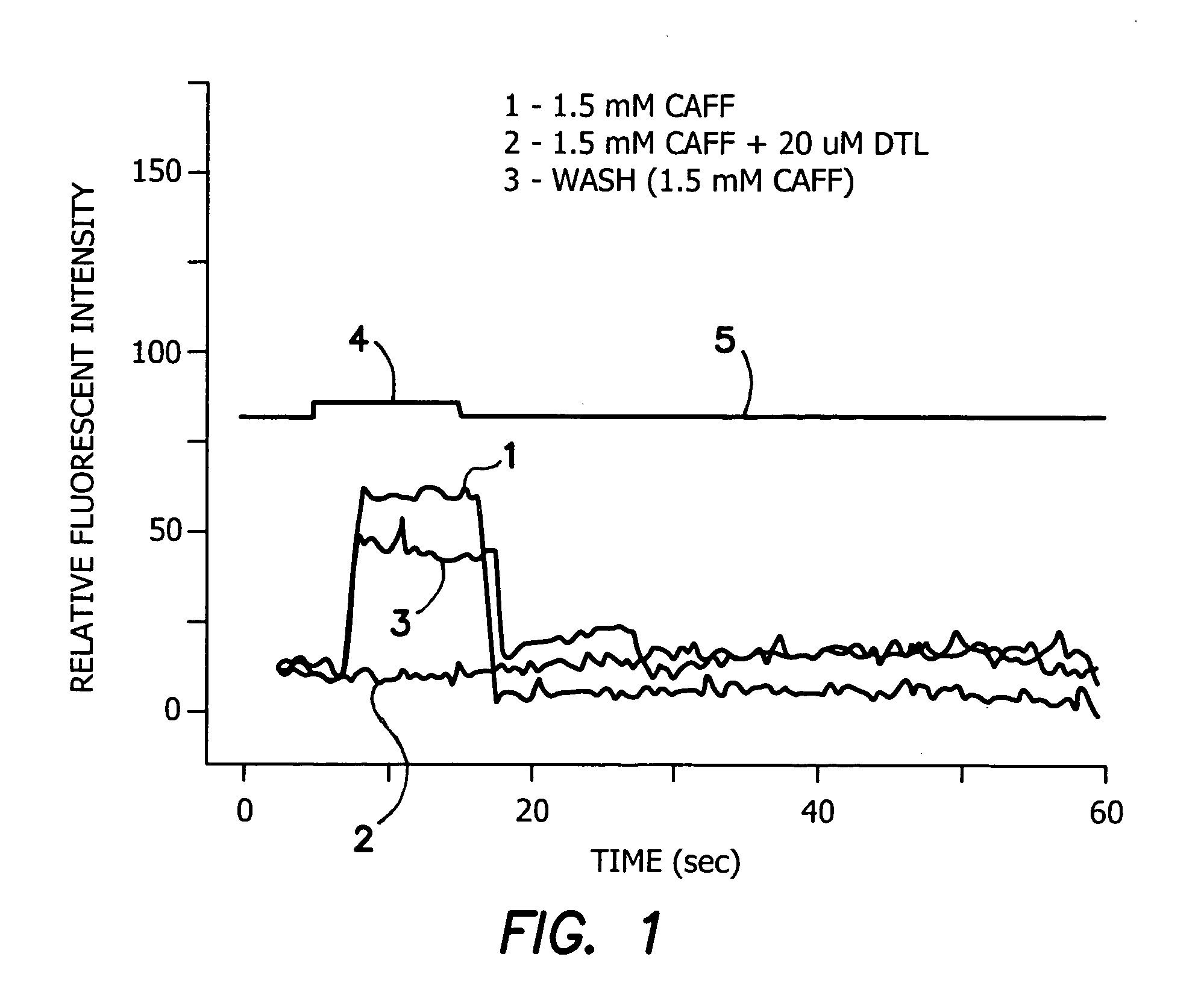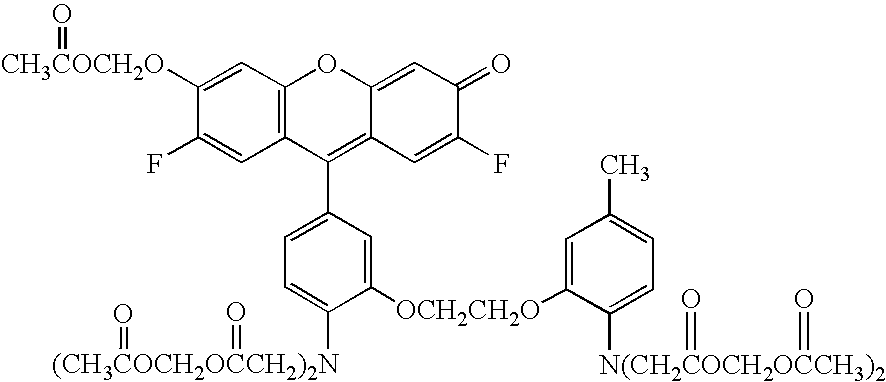Methods of determining activity of ryanodine receptor modulators
a technology of ryanodine receptor and activity, applied in the field of identifying ryanodine receptor modulators, to achieve the effect of different absorption and/or emission maxima
- Summary
- Abstract
- Description
- Claims
- Application Information
AI Technical Summary
Benefits of technology
Problems solved by technology
Method used
Image
Examples
example 2
Cloning of Ryanodine Receptor into pcDNA 3
[0042] The DNA encoding the ryanodine receptor is obtained from PCR amplification of total RNA (mRNA) cDNA from human skeletal muscle cells. For RyR2, cardiac muscle cells may be used, and brain tissue may be used for the isolation of RyR3 mRNA. RNA is collected from the muscle cells using standard and well-known procedures. The RNA is reverse transcribed in a reaction mixture containing 1 μg muscle cell whole RNA, 12.5 mM each dNTP, 50 mM Tris-HCl (pH 8.3), 40 mM KCl, 5 mM DTT (dithiolthreitol), 20 pmoles of a random deoxyribonucleotide hexamer, and 100 units SUPERSCRIPT® reverse transcriptase. The reaction mixture is incubated at 42° C. for 1 hour, then at 95° C. for 5 minutes, and stored at 4° C. until use.
[0043] PCR reactions of the cDNA preparation are performed using appropriate oligonucleotide primers complementary to (or identical to) either the 5′ or 3′ portion of the RyR1 mRNA nucleotide sequence. The sense primer incorporates a...
example 3
Transfection of Cells with pRYAN01 and Expression of the Protein
[0049] The host cells chosen to demonstrate expression of the chimeric protein of the present invention are HEK293 cells. This cell line is known to express functional RyR proteins and can be used for large scale RyR modulator screening by transfection and expression of a recombinant vector such as pRYAN01, that encodes RyR1.
[0050] HEK293 cells are grown in Dulbecco's Modified Eagle Medium supplemented with 4500 mg / nl D glucose, 584 mg / ml L-glutamine, and 10% fetal bovine serum (FBS). For transformations, cells are seeded at 1-2×105 cells / ml and incubated at 37° C. at 5% CO2 until 50-70% confluent. By percentage confluent is meant the percentage of the substrate, such as the microtiter dish bottom, that is occupied by cells.
[0051] The cells are then transfected as follows. For each transfection a solution is made by mixing 20 μl LIPOFECTIN® (a cationic lipid preparation containing a 1:1 molar ratio of DOTMA (N->1-(2...
example 4
Ca++ Release from Ryanodine Receptors
[0052] The ability of a selected modulator (test substance) of the ryanodine receptor was used to model the assay of the present invention in the rat retinal ganglion cell as follows.
[0053] Rabbit retina was isolated from rabbit eyes using standard techniques, and was maintained in Ames' medium (Sigma Aldrich) during the course of the experiment. The cells were provided intracellularly with a calcium-sensitive fluorescent dye (Fluo-4®) using a patch clamp electrode. The structure of this dye, which can be purchased from the Molecular Probes division of Invitrogen, Inc., is as follows:
[0054] The isolated retina was placed in a recording chamber and superfused continuously with Ames' medium. Caffeine and dantrolene were was delivered briefly (i.e., approximately 10 seconds) to each cell tested through a computer-controlled multichannel rapid local perfusion system using a micro pipette which is 100-200 microns in diameter and was positioned cl...
PUM
| Property | Measurement | Unit |
|---|---|---|
| Concentration | aaaaa | aaaaa |
| Permeability | aaaaa | aaaaa |
| Fluorescence | aaaaa | aaaaa |
Abstract
Description
Claims
Application Information
 Login to View More
Login to View More - R&D
- Intellectual Property
- Life Sciences
- Materials
- Tech Scout
- Unparalleled Data Quality
- Higher Quality Content
- 60% Fewer Hallucinations
Browse by: Latest US Patents, China's latest patents, Technical Efficacy Thesaurus, Application Domain, Technology Topic, Popular Technical Reports.
© 2025 PatSnap. All rights reserved.Legal|Privacy policy|Modern Slavery Act Transparency Statement|Sitemap|About US| Contact US: help@patsnap.com


